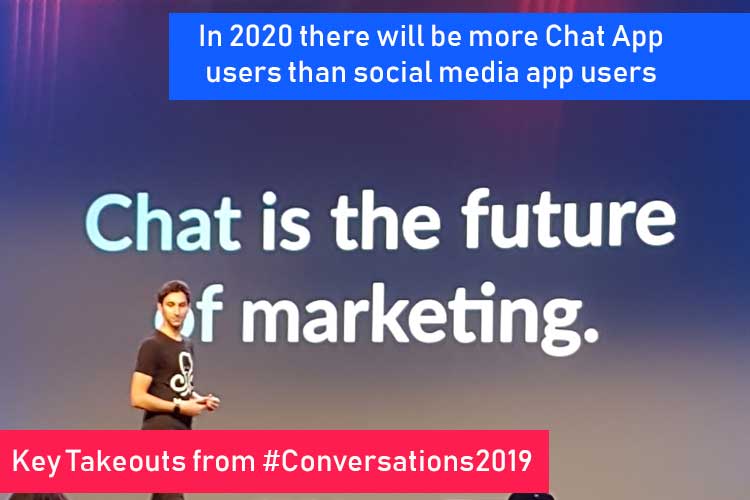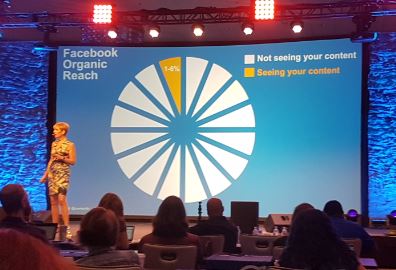
We’re fresh off the plane from 3 days of exhilarating content at Conversations2019 in Austin Texas. Manychat’s second annual Conference was full of actionable insights to help drive your business forward, and in this post we review the key take outs.
Kicking off, it looks like 2020 is set to be a milestone year for Messenger Marketing. According to Mikael Yang, CEO at Manychat, monthly active chat app users will surpass the number of social media chat users for the first time. That’s more than just an interesting statistic. As marketers, we must always understand where our customers are likely to be hanging out. If you’re selling products or services to consumers, your customers are almost certainly spending time in chat apps, which means you NEED to be engaging with them there.
Aside from China where Wechat rules the roost, the majority of the western world has adopted either Facebook Messenger, Whatsapp or Instagram Messaging as their platform of choice, and many people use multiple channels simultaneously. All 3 of these channels are properties of Facebook, who have announced seamless interoperability between them will be released next year. That means that a Messenger user will be able to chat with a Whatsapp user and visa versa without leaving their app of choice. For you as a business owner or marketer it means unprecedented and seamless access to just about all your customers from one single platform!
But it gets better!
At the conference, Manychat unveiled one of the biggest advancements in the history of marketing systems. No longer confined to just Facebook Messenger, Manychat now supports engagement via email and SMS. This is exciting news because it means we’ll be able to leverage multiple channels as traffic sources to filter customers back onto our Messenger conversations. Based on either the customer data we hold, or the user’s own preferences, we’ll be able to seamlessly switch to a second or even third channel if a conversations gets dropped in Messenger. This neatly solves the challenges faced by Facebook’s upcoming messaging restrictions.
While native email messaging capability is already available for all countries, SMS integration is currently only available for US customers. Technically the implementation is done, but Manychat are working through the legal and compliance restrictions around SMS in each location. We quietly had a word to Manychat Co-Founder Anton Gorin, who let us know that they expect SMS services to be available in Australia by the end of the year (2019).
Messenger Marketing is old news. Long Live Chat Marketing!
Across the course of 3 days, we heard from a diverse set of speakers, including the ‘Queen of Facebook’ Mari Smith, Randi Zuckerberg, Neil Patel, Ezra Firestone, and many others. Topics covered everything from how to create a chat campaign to sell Girl Guides Cookies, to using Messenger and eWallet to sell $7m of training subscriptions in just 7 days. The general consensus was that Messenger funnels are out-performing other channels, often by as much as 10X.
If Messenger is the best converting sales funnel, the key question all marketers should be asking is ‘whats the best way to drive more traffic into it?’
In summarizing all the presentations, we highlight 7 key strategies you should explore.
Strategies for Customer / Traffic Acquisition
1. Facebook Ads to Messenger.
This is not new, but we start here because we consider this to be the core strategy for customer acquisition. Send To Messenger and Comment Growth Tool strategies are the most effective overall as they offer the lest friction to user experience, therefore the lowest CPA.
You can also use the same conceptual strategy on standard Facebook posts. At the conference, Manychat announced a new ‘All Posts’ growth tool, which means you can invite customers into a conversations from any comment on any post. That’s pretty cool for organic (unpaid) traffic.

One important point about organic posts. Both Mari Smith and Neil Patel showed statistics indicating the significant demise of organic reach. Standard (non promoted) posts now only reach about 6% of your Audience, while post engagement has fallen consistently for the past 4 years. Video content is most widely distributed, followed by static images, while link posts are actively suppressed (because Facebook wants users to stay on-platform). Mari recommends about 70% video, 20% static image, and 10% link posts in your mix.
2. Facebook Live to Messenger.
A key message that came through in several presentations was that the only place ‘faceless’ brands can exist is on Amazon. Your product or service brand is heavily underpinned by your own personal brand. With the exponential growth of video in recent years, live casting has become an important strategy. Apart from being able to engage with live viewers, you’re creating video assets which can be used to generate engagement and sales long after the live has ended.
Leveraging Messenger to build an audience and remind them of the upcoming live event beforehand is a great way to gain momentum, while delivering show notes and other content using a comment growth tool is a powerful way to transition viewers into subscribers. What’s new here is that Facebook is showing significant love to Live’s, so it’s possibly the best way to get organic traffic into your Messenger channel from within Facebook.
 3. Blog to Messenger.
3. Blog to Messenger.
According to Neil Patel, for many businesses the first interaction new customers have with your brand is via a blog post. Indeed, statistics show that Blog posts are generating more initial touchpoints between brands and users in 2019 than ever before.
Instead of creating a CTA at the end of the post that takes the user to a landing page or email sign-up, we recommend creating a compelling CTA that brings the potential customer into a Messenger conversation. That could be to deliver a lead magnet, take a quiz, or make a direct offer.
4. LinkedIn to Messenger.
If you’re in the B2B space, leveraging the targeting power of LinkedIn is a no-brainer. But did you realise that Messenger can form a powerful and highly engaging way to deliver content? LinkedIn has its own messaging channel, but open and action rates there are much lower than Messenger. When posting, doing live casting or contacting potential leads, providing links to Messenger (using REFURL growth tools) can give you an extra channel to communicate. Plus, it can potentially convert your LinkedIn prospects to active conversations at a much higher rate.
5. Leverage Website Live Chat
It has been shown that for eCommerce brands in particular, having a 24/7 live chat support option can deliver a 13-30% increase in website conversion. Embedding the Messenger live chat to your site enables you to deliver BOT interaction for customer FAQs. However, your goal for this service should be to handle the majority of enquiries automatically, but have real humans available to jump in and provide sales support. Be prepared though, delivering a templated ‘out of hours’ message can lead to a bad user experience, leading your potential customer to choose a competitor.
You can learn more about how to leverage Live Chat to make sales here.
Strategies for Re-Engagement
6. Optimizing funnel performance with dynamic retargeting
One of the incredible features of Manychat is the ability to dynamically add (or remove) individuals from a custom audience in Facebook depending on actions they take. This is powerful because it means that you can re-engage customers depending on very specific criteria. In this way, you can handle objections and enable customers to pick up conversations from where they left off.
The consensus among the top minds in Facebook advertising though, is that Sponsored Messages (which appear in the user’s Messenger feed) are not delivering the best results right now. Facebook is working hard to fix this, but for now we recommend using one of the traditional Ad objectives with your dynamic audiences.
7. Dynamic Cross-Channel Re-Engagement
Our modern world is full of distractions, and it’s easy for even motivated customers to lose track of a conversation before making the sale. For this reason, it’s always been good practice to include time-based reminders inside Messenger to prod the customer to the next step.
However the integration to SMS and email announced this week enables you to easily re-engage the customer across more than just the Messenger channel. For example, if 24 hours has passed since your last interaction, drop an SMS reminder through with a link back to the conversation in Messenger. Then you can revert to email for more long-term engagement, perhaps delivering some additional value to help handle any objections your customer may have.
You’ll also be able to use these other channels for when you want to send messages that don’t conform to Facebook’s Terms of Service, including promotional messages, coupon reminders and the like. This enables you to still engage on the platform without worrying about spammy broadcasts or losing your Facebook account.
Right now these features are in first release, and there are a few bugs Manychat still need to smooth out. Email formatting isn’t very rich, and there’s currently no way to adjust the sender profile (reply-to). There are also question marks around unsubscribing and whether if a person unsubscribes from email they also unsubscribe from your Messenger list. The team assures us they are working hard on all these items, and should have a resolution soon.
The strategies laid out above, plus the development of Manychat’s new Chat Marketing ecosystem mean there’s never been a better time to leverage Facebook Messenger as a critical part of your marketing strategy. Successful execution of an omnichannel strategy requires a thoughtful and considered approach in relation to your customer journeys. Which traffic sources will you leverage, and how will you engage a conversation? How will you re-engage, and which channel should you use?
For a free no-obligation strategy consult for your business, contact us in Facebook Messenger today.

